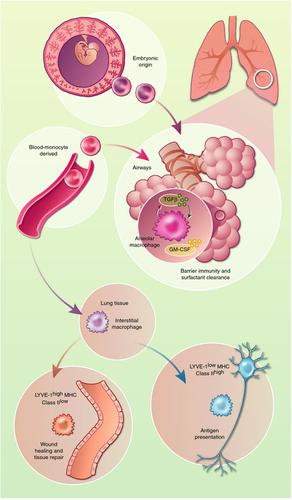当前位置:
X-MOL 学术
›
Immunology
›
论文详情
Our official English website, www.x-mol.net, welcomes your
feedback! (Note: you will need to create a separate account there.)
Origin and ontogeny of lung macrophages: from mice to humans.
Immunology ( IF 4.9 ) Pub Date : 2019-12-04 , DOI: 10.1111/imm.13154 Elza Evren 1 , Emma Ringqvist 1 , Tim Willinger 1
Immunology ( IF 4.9 ) Pub Date : 2019-12-04 , DOI: 10.1111/imm.13154 Elza Evren 1 , Emma Ringqvist 1 , Tim Willinger 1
Affiliation

|
Macrophages are tissue-resident myeloid cells with essential roles in host defense, tissue repair, and organ homeostasis. The lung harbors a large number of macrophages that reside in alveoli. As a result of their strategic location, alveolar macrophages are critical sentinels of healthy lung function and barrier immunity. They phagocytose inhaled material and initiate protective immune responses to pathogens, while preventing excessive inflammatory responses and tissue damage. Apart from alveolar macrophages, other macrophage populations are found in the lung and recent single-cell RNA-sequencing studies indicate that lung macrophage heterogeneity is greater than previously appreciated. The cellular origin and development of mouse lung macrophages has been extensively studied, but little is known about the ontogeny of their human counterparts, despite the importance of macrophages for lung health. In this context, humanized mice (mice with a human immune system) can give new insights into the biology of human lung macrophages by allowing in vivo studies that are not possible in humans. In particular, we have created humanized mouse models that support the development of human lung macrophages in vivo. In this review, we will discuss the heterogeneity, development, and homeostasis of lung macrophages. Moreover, we will highlight the impact of age, the microbiota, and pathogen exposure on lung macrophage function. Altered macrophage function has been implicated in respiratory infections as well as in common allergic and inflammatory lung diseases. Therefore, understanding the functional heterogeneity and ontogeny of lung macrophages should help to develop future macrophage-based therapies for important lung diseases in humans.
中文翻译:

肺巨噬细胞的起源和个体发育:从小鼠到人类。
巨噬细胞是驻留在组织中的髓样细胞,在宿主防御,组织修复和器官稳态中起重要作用。肺中有大量巨噬细胞,它们位于肺泡中。由于其地理位置优越,肺泡巨噬细胞是健康的肺功能和屏障免疫的重要前哨。它们吞噬吸入的物质并启动对病原体的保护性免疫反应,同时防止过度的炎症反应和组织损伤。除肺泡巨噬细胞外,在肺中发现了其他巨噬细胞群,最近的单细胞RNA测序研究表明,肺巨噬细胞的异质性大于以前的认识。小鼠肺巨噬细胞的细胞起源和发育已被广泛研究,但关于人类肺巨噬细胞的个体发育知之甚少,尽管巨噬细胞对肺部健康很重要。在这种情况下,人性化的小鼠(具有人类免疫系统的小鼠)可以通过进行人类不可能进行的体内研究,从而对人类肺巨噬细胞的生物学产生新的见解。特别是,我们已经创建了支持人肺巨噬细胞在体内发育的人源化小鼠模型。在这篇综述中,我们将讨论肺巨噬细胞的异质性,发育和体内稳态。此外,我们将强调年龄,微生物群和病原体暴露对肺巨噬细胞功能的影响。巨噬细胞功能的改变与呼吸道感染以及常见的过敏性和炎症性肺疾病有关。因此,
更新日期:2019-12-04
中文翻译:

肺巨噬细胞的起源和个体发育:从小鼠到人类。
巨噬细胞是驻留在组织中的髓样细胞,在宿主防御,组织修复和器官稳态中起重要作用。肺中有大量巨噬细胞,它们位于肺泡中。由于其地理位置优越,肺泡巨噬细胞是健康的肺功能和屏障免疫的重要前哨。它们吞噬吸入的物质并启动对病原体的保护性免疫反应,同时防止过度的炎症反应和组织损伤。除肺泡巨噬细胞外,在肺中发现了其他巨噬细胞群,最近的单细胞RNA测序研究表明,肺巨噬细胞的异质性大于以前的认识。小鼠肺巨噬细胞的细胞起源和发育已被广泛研究,但关于人类肺巨噬细胞的个体发育知之甚少,尽管巨噬细胞对肺部健康很重要。在这种情况下,人性化的小鼠(具有人类免疫系统的小鼠)可以通过进行人类不可能进行的体内研究,从而对人类肺巨噬细胞的生物学产生新的见解。特别是,我们已经创建了支持人肺巨噬细胞在体内发育的人源化小鼠模型。在这篇综述中,我们将讨论肺巨噬细胞的异质性,发育和体内稳态。此外,我们将强调年龄,微生物群和病原体暴露对肺巨噬细胞功能的影响。巨噬细胞功能的改变与呼吸道感染以及常见的过敏性和炎症性肺疾病有关。因此,











































 京公网安备 11010802027423号
京公网安备 11010802027423号